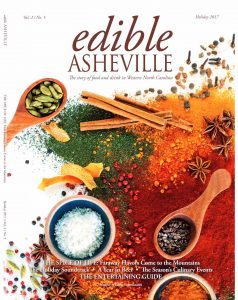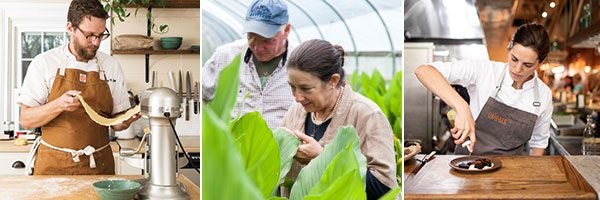CONTAINING MULTITUDES
From fashion to apples, reveling in the possibilities of transformation
BY ASHLEY ENGLISH | PHOTOS BY ERIN ADAMS
I was a teenager when I first heard Walt Whitman’s quote about contradicting oneself. I was reading his 1855 poem “Song of Myself” in which he writes:
Very well then I contradict myself.
I remember immediately, enthusiastically, resoundingly agreeing with it. Like most teens, I found myself awash in a sea of identity options at that tender time, struggling to find footing with determining and defining who exactly I was. If I was reading a new Anne Rice novel (this was the 90s, after all), I fancied myself a bit of a loner, a misfit, dressing and acting accordingly, talking little, listening to The Cure on repeat, and outfitting myself in all black.The very next day, however, I might imagine myself a club kid (still in the 90s, remember), listening to The Chemical Brothers, and don garish, oversized purple polyester pants and a fire engine red midriff baring t-shirt with the U.S. Postal Service logo on it, chatting up everyone I encountered.
Therein lies the beauty of the human experience. Unlike other creatures we share this planet with, even those who undergo significant physical metamorphoses in their journeys to self-actualization, we are at liberty to radically redefine ourselves. From our appearances to our beliefs, and from our vocations to our passions, it’s all subject to change, at any given moment, based on circumstance, whim, and inclination (not to mention as a reflection of what’s happening in the larger cultural, public discourse at the time).
While for some, this instability—shape-shifting, as it were, at will—is unnerving, for others, myself included, it’s beyond liberat- ing. I have long been enamored of those stories I encounter about profound personal transformation, especially those encountered mid-career, or mid-life. The stockbroker who leaves Wall Street to become an elementary school teacher, or the attorney who quits law to take up goat-keeping and chèvre-making. These tales of transformation and reinvention attest to our ever-evolving capacities to take on new skills, and to shed skins that no longer suit us. That was then, but this? This is now.
Lest you think I find seismic shifts in one’s definition and presentation of self the most authentic, most fulfilling way to lead a life, do know that I laud the abiding, linear path just as ardently. If you knew at age 8, deep down in your bones and beyond a shadow of a doubt, that you wanted to become a veterinarian, majored in biology in college, went to veterinary school, and practiced as a veterinarian for 40 years before retiring, then bravo! But if, say, at age 43, you realize you’d much rather pass your days writing children’s books, sell your clinic, and detail the antics of a fictionalized dog rather than tend to those of a real one, I equally applaud you.
All of which brings me to apple butter. In my estimation, apples are perfect on their own. Crisp, sweet or tart, at home in a pie or tucked into a meatloaf (trust me on this one), the fruits are without reproach. That said, the transformations they’re capable of undergoing, creating myriad iterations and permutations, are just as dazzling. From applesauce to hard cider, from vinegar to fruit leather, there are few things you can’t do with apples.
Here I’m offering my recipe for apple butter, wherein apples are cooked into tender submission with the aid of fresh cider, pureed velvety smooth, and then slowly simmered with sugar and spices until thickened. A further transformation occurs when that apple butter is then rendered into a vinaigrette. As we enter fall here in Western North Carolina, my sincere hope is that fresh apples, apple butter, and apple butter vinaigrette all make their way into your kitchen. From first bite of crisp apple to enjoyment of sweet and sour vinaigrette, the journey is just as worthwhile as the destination, and the transformation.◊◊
Apple Butter
Recipe reprinted with permission from Southern From Scratch: Pantry Essentials and Down-Home Recipes, Ashley English, Roost Books 2018
Makes 4 to 5 half-pints
5 pounds cooking apples, peeled, cored, and coarsely chopped
2 teaspoons ground cinnamon
1⁄2 teaspoon ground nutmeg
1⁄2 teaspoon ground ginger
Next, either press the cooked apple mixture through a food mill or fine-meshed sieve, puree it in a food processor once slightly cooled, or use an immersion blender and puree the mixture in the pot. If using a food processor or blender, blend just until smooth, but not runny.
Using a jar lifter, remove the hot jars from the canner and place on top of a kitchen cloth on the counter. With the help of a canning funnel, pack the apple butter into the jars, reserving 1⁄4-inch headspace.
Use a spatula or wooden chopstick to remove any trapped air bubbles around the interior circumference of the jar. Wipe the rims clean with a damp cloth. Place on the lids and screw bands, tightening only until fingertip-tight.
Again using a jar lifter, slowly place the filled jars into the canner. Be sure that there’s at least 1 inch of water above the top of the jars. Bring to a boil, and then process for 10 minutes, starting the timer once the water is at a full, rolling boil. Adjust for altitude as needed.
_________________________________________________________________________________________
Ashley English is the author of several books, including Southern from Scratch: Pantry Essentials and Down-Home Recipes and A Year of Picnics: Recipes for Dining Well in the Great Outdoors. She lives in Candler, North Carolina, with her husband, two sons, and a menagerie of chickens, dogs, cats, and bees. Smallmeasure.com
Save
Save
Save
Save
Save
Save
Save
Save
Save
Save
THE WEEKLY REVEL
Sign up for your free handpicked guide to enjoying life around Asheville.
Available weekly from May to October.





